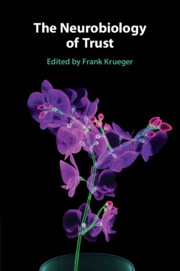Book contents
- The Neurobiology of Trust
- The Neurobiology of Trust
- Copyright page
- Dedication
- Contents
- Figures
- Tables
- Contributors
- Abbreviations
- Introduction
- Part I Fundamental Level of Trust
- Part II Neuropsychological Level of Trust
- Chapter 5 Trust and Risk
- Chapter 6 Trust and Emotion
- Chapter 7 Trust and Reputation
- Chapter 8 Trust and Learning
- Part III Neurocharacteristic Level of Trust
- Part IV Neuromolecular Level of Trust
- Part V Neuropathological Level of Trust
- Index
- References
Chapter 8 - Trust and Learning
Neurocomputational Signatures of Learning to Trust
from Part II - Neuropsychological Level of Trust
Published online by Cambridge University Press: 09 December 2021
- The Neurobiology of Trust
- The Neurobiology of Trust
- Copyright page
- Dedication
- Contents
- Figures
- Tables
- Contributors
- Abbreviations
- Introduction
- Part I Fundamental Level of Trust
- Part II Neuropsychological Level of Trust
- Chapter 5 Trust and Risk
- Chapter 6 Trust and Emotion
- Chapter 7 Trust and Reputation
- Chapter 8 Trust and Learning
- Part III Neurocharacteristic Level of Trust
- Part IV Neuromolecular Level of Trust
- Part V Neuropathological Level of Trust
- Index
- References
Summary
Learning to trust the right partner is pivotal to survival. But what information matters to decide whom to trust? In this chapter, we review evidence suggesting that different character traits play a role in the formation of trustworthiness impressions and beliefs that guide trust decisions. Learning of these traits depends on available information about the other person, previous knowledge, and contextual circumstances. Interestingly, when these factors favor the learning of particular traits, the resulting beliefs are harder to revise and lead to behavioral patterns that suggest a learning impairment. Computational models indicate an asymmetry in feedback valuation that is not due to the type of feedback (e.g., positive or negative) but rather to previous knowledge and contextual factors (e.g., the reputation of the other person). Neuroimaging studies highlight the role of mentalizing brain regions in building adequate mental models of others. Specifically, the orbitofrontal cortex and temporoparietal junction are central to the formation and updating of trustworthiness beliefs. Further, the dorsal posterior cingulate cortex and lateral frontoparietal regions likely underpin information integration processes for behavior change in face of untrustworthiness. We finally call for collaborative efforts in future scientific enterprises to develop a still lacking neurocomputational theory of social learning.
Keywords
- Type
- Chapter
- Information
- The Neurobiology of Trust , pp. 185 - 218Publisher: Cambridge University PressPrint publication year: 2021



